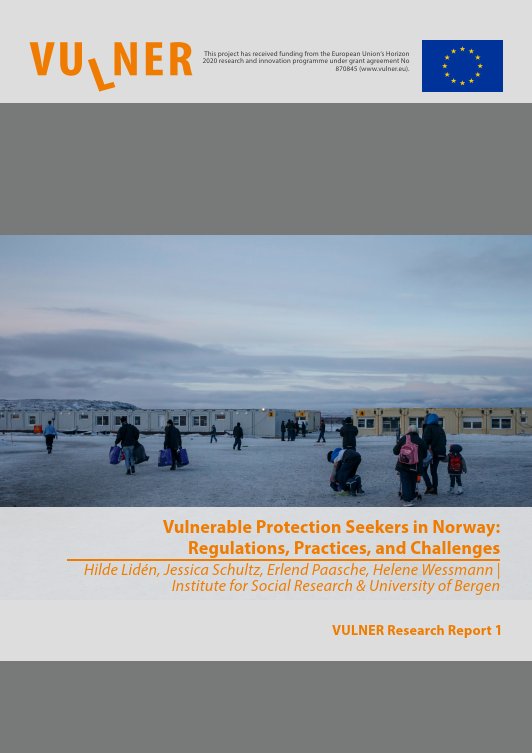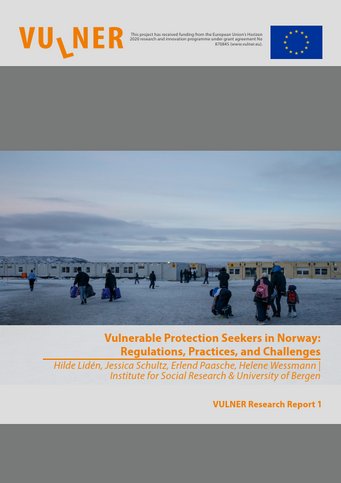Vulnerable Protection Seekers in Norway: Regulations, Practices, and Challenges
by Hilde Lidén, Jessica Schultz, Erlend Paasche, Helene Wessmann

This research report presents some of the intermediate research results of the VULNER project, based on the first phase of the project, which consisted of mapping out the vulnerability assessment mechanisms developed by state authorities in Norway, including how they are implemented on the ground through the practices of the public servants in charge.
The following research questions are addressed: What do the relevant domestic legislation, case-law, policy documents, and administrative guidelines reveal about how “vulnerabilities” are being assessed and addressed in the countries under study? Do the relevant state and/or aid agencies have a legal duty to assess migrants’ vulnerabilities, and if yes, using which procedures, when and how? Following which legal and bureaucratic criteria? How do decision-makers (street-level bureaucrats) understand and perceive the ‘vulnerabilities’ of the migrants they meet on a daily basis? How do they address these ‘vulnerabilities’ through their everyday practices? What is their stance on existing legal requirements towards ‘vulnerable’ migrants? Which loopholes do they identify?
To that end, the objective of the legal enquiry was to analyse and reflect upon how ‘vulnerability’ is being developed as a legal and bureaucratic concept in the Norwegian regulations. Legal sources include national laws and regulations related to immigration and welfare (health, child welfare, and social security), as well as more than a hundred administrative guidelines. The main policy documents included in the analysis consist of white papers, resolution proposals, and written political interventions.
The empirical research methods were conducted to complement and deepen the legal analysis. The aim of this part of the study was to document and analyse how the ‘vulnerabilities’ of the protection seekers are understood and addressed by the relevant decision-makers in their everyday practices. The recruitment of participants (36 persons) consisted of representatives of the Ministry of Justice, street-level bureaucrats in the Directorate of Immigration (UDI), judges on the Appeal Board (UNE), the management in reception centres, representatives for the welfare system, legal guardiens and experts on vulnerable groups.
This led to the following key findings:
• In Norway, human rights discourse is the normative center of asylum law and policies. The concept of vulnerability is neither explicit in legislation nor in the Immigration Regulations but is implicit in the principles of non-discrimination and equal treatment.
• Still, certain groups and persons are given special attention with reference to the state obligations derived from specific international conventions, creating a hierarchy of vulnerabilities. Most attention is focused on minors, gender-related issues, sexual identity and victims of human trafficking for the purpose of prostitution.
• There is no specific procedure for identifying especially vulnerable protection seekers. Instead, the responsibility to identify special needs is integrated in ordinary registration and asylum procedures, and as such dispersed among different institutions.
• Practitioners we interviewed tended to use the vulnerability concept in a descriptive manner, to highlight the complex and often interrelated factors that expose people to harm. The vulnerability discourse, then, is gaining traction in practices. This is particularly the case for procedural adjustments and guarantees, assessing humanitarian grounds and in the context of reception conditions.
• Norwegian law excludes consideration of whether removal to a place outside the person’s previous residence (an “internal protection alternative”) would be reasonable for the person concerned, meaning that vulnerabilities associated with ‘return’ to internal displacement are structurally overlooked in decisions related to the grant or withdrawal of refugee status.
• If a protection seeker does not fulfill the criteria for refugee status, vulnerability factors are considered as part of the assessment of whether “strong humanitarian considerations” justify a residence permit. Here, vulnerabilities related to health, age and trafficking experience are considered along with compound factors that would make return indefensible from a humanitarian perspective.
• Access to humanitarian status is influenced by overall asylum flows. The duty of a decision- maker to balance individual factors against state interests leads to the exclusion of many protection seekers with profound vulnerabilities, including physical and mental health problems. This is particularly true when the protection seeker comes from a country with many similarly situated people, raising equal treatment concerns between countries.
• The weight given to the best interests of children as a “fundamental consideration” varies widely depending on the competing state interests.
• The increased use of time-limited permits for persons with humanitarian status who have not proven their identity increases the vulnerability of people with a recognized right to remain.
• Despite the plethora of guidance on certain vulnerabilities, there are situations and instruments that are not adequately addressed. For example, vulnerabilities experienced by victims of torture (CAT) and persons with disabilities (CRPD) may be overlooked or considered less credibile.
Download the full report here.
